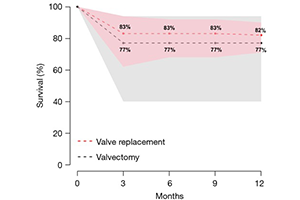Valvectomy versus replacement for the surgical treatment of infective tricuspid valve endocarditis: a systematic review and meta-analysis
Abstract
Background: Optimal surgical treatment of infective tricuspid valve endocarditis in patients with intravenous drug use (IVDU) remains controversial. Tricuspid valvectomy has been proposed for infective tricuspid valve endocarditis in this patient population given the inherent social concerns. The aim of this systematic review and meta-analysis was to compare outcomes of valvectomy versus replacement for the surgical treatment of isolated infective tricuspid valve endocarditis.
Methods: An electronic search was performed to identify all relevant studies published. After assessment for inclusion and exclusion criteria, 16 original studies were pooled for systematic review and meta-analysis.
Results: There were a total of 752 patients with infective tricuspid valve endocarditis, of which 14% underwent valvectomy and 86% underwent replacement (mean follow-up 4.2 years, 95% CI, 1.9–6.4 years). The most common indications for surgical intervention were septic pulmonary embolism in the valvectomy group (74%, 95% CI, 28–95%) and persistent sepsis in the replacement group (62%, 95% CI, 31–86%). There were no differences in rates of stroke [valvectomy 4% (95% CI, 1–11%) vs. replacement 3% (95% CI, 1–16%), P=0.85] but there was increased likelihood of prolonged ventilation in those who underwent valvectomy [valvectomy 40% (95% CI, 30–51%) vs. replacement 26% (95% CI, 23–30%), P<0.01]. There were no differences in 30-day post-operative mortality [valvectomy 13% (95% CI, 5–30%) vs. replacement 7% (95% CI, 5–10%), P=0.21], post-operative right heart failure [valvectomy 27% (95% CI, 10–53%) vs. replacement 11% (95% CI, 5–25%), P=0.17] and recurrent endocarditis [valvectomy 7% (95% CI, 2–23%) vs. replacement 19% (95% CI, 12–28%), P=0.81]. Valvectomy had a higher rate of tricuspid valve reoperation [valvectomy 56% (95% CI, 15–90%) vs. initial replacement 14% (95% CI, 7–27%), P=0.06].
Conclusions: Tricuspid valvectomy is an acceptable initial therapy for infective tricuspid valve endocarditis in patients with IVDU, providing a bridge to identify those who will self-select as candidates for staged valve replacement.
Cover






